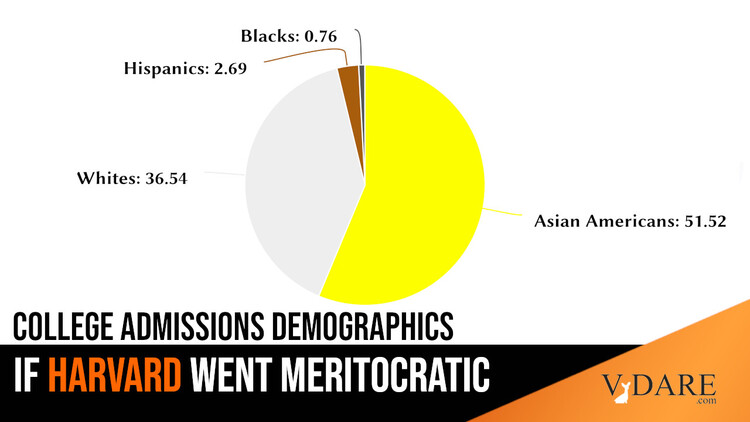
JOHN DERBYSHIRE: “Nobody Wants An 0.76 Percent Black Harvard. The Oceans Would Boil, The Earth Would Crash Into The Sun.”
06/30/2023
[Adapted from the latest Radio Derb, now available exclusivelyon VDARE.com]
A few days ago, I had the delightful and instructive experience of sitting down to dinner with Charles Murray, whose latest book, Facing Reality came out just two years ago. The “reality” in the title is reality about race differences, most particularly differences in intelligence and criminality. Murray spells out the differences in patient, well-documented detail.

The book went deeply un-reviewed. Everybody of any importance in the USA turned their faces away from it. Hardly anyone wants to face reality.
Before covering the Supreme Court’s Affirmative Action decision made public this week, I should offer a mild apology.
Two weeks ago on Radio Derb, looking forward to the Supremes’ end-of-month ruling, I said:
The fundamental problem here is to find some middle way between meritocratic college admissions, which are unacceptable, and naked favoritism — otherwise known as “holistic” admissions, which ought to be unacceptable in a fair society.
The meritocratic option is unacceptable because of race differences in intelligence. On a strictly meritocratic admissions process, one that totally depended on results from tests of cognitive ability, the Ivy League would be forty percent East Asian, forty percent white, two percent black, and eighteen percent other — other Asian plus nonwhite Hispanics.
Those are the numbers as I thought I remembered reading them somewhere, and I didn’t bother to confirm them with an internet search. Sloth, as I have mentioned before, is the only one of the Seven Deadly Sins that gives me serious trouble, and I’m afraid I let Sloth take the wheel there.
Fortunately, I have attentive listeners to correct my shortcomings. One such directed me to the Expert Report submitted to the Supremes five years ago in the key case here, Students for Fair Admissions, Inc. v. Harvard.
The report was compiled by Peter Arcidiacono, who is Professor of Economics at Duke University. You can of course read it on the internet. Set aside some time, though; it’s 168 pages.
On page 44 you’ll find Table 5.3, heading: “Share of admits of each race/ethnicity if equally drawn from different academic index deciles.” What’s that all about?

Well, Prof. Arcidiacono is exploring what the racial proportions of admissions to Harvard would look like if the admissions were determined solely by applicants’ academic records — solely by merit.
He breaks it down by deciles. That is to say, what would the proportions look like if Harvard selected from the topmost tenth of applicants — topmost by their academic records, that is — then what if they selected from the topmost two-tenths, topmost three-tenths, and so on?
Key takeaway: If Harvard were to select from just the top one-tenth of applicants ranked by academic record — which is in fact what Harvard most likely would do — then Asian Americans would be 51.52 percent, Whites 36.54, Hispanics 2.69 percent, blacks 0.76 percent.
So the numbers I gave you two weeks ago, that in my sloth I thought I remembered, were probably mean to Asians (although since I broke out Fancy Asians from Jungle Asians and the good professor doesn’t, it’s hard to tell).
My numbers were certainly way too generous to blacks: my two percent should have been less than one percent. On whites I was close enough: I said forty percent, Prof. Arcidiacono says 36½.
And I should add that the actual percentage of blacks in the class admitted when Prof. Arcidiacono compiled his report was 15.81. That’s nearly twenty-one times the meritocratic figure of 0.76. Actual percentage of Asians was 24.86. That’s less than half the meritocratic figure of 51.52. That’s what this lawsuit was all about.
Actual percentage of whites: a slight tick above the meritocratic figure, perhaps on account of legacies.
If my numbers were squishy, though, my main point was correct. To quote myself once again:
The meritocratic option is unacceptable because of race differences in intelligence.
That’s the nub of the matter. What follows from it isn’t hard to predict. I predicted it, and shall re-predict it here.
My prediction two weeks ago was that if the Supreme Court decision ordered college admissions officers to give up race favoritism, those officers would weasel their way out of it somehow.
In fact, as I noted, they were already doing this by no longer requiring applicants’ scores on rigorous tests like the SAT and ACT.
Without those scores, tables like the one of Prof. Arcidiacono’s that I quoted can’t be constructed. There’s no data to work from.
I should have added, because I had already figured it out, that the Supreme Court’s decision, however it went, would contain a trapdoor through which the college admissions officers could escape.
Both the previous two big rulings on this topic, the Bakke decision of 1978 and Grutter in 2003, offered such trapdoors.
In Bakke, the Court said that while the defendant college’s frank quota system was indeed unconstitutional, there was none the less a compelling governmental interest in a racially diverse student body; and that so long as race was just one of several factors admissions officers considered, that would be constitutionally OK. Call that the “one of several factors” trapdoor.
In Grutter 25 years later the Court upheld Bakke, affirming that diversity in the student body was a compelling interest from which “educational benefits” would flow. However, it qualified the decision by saying that “race-conscious admissions policies must be limited in time.”
Justice Sandra Day O’Connor, author of the majority opinion, guessed that after 25 years (i.e., by 2028!) there would no longer be any need for those policies. Call that the “limited in time” trapdoor.
Both those big decisions, with their built-in little trapdoors for admissions officers to escape through, left those officers free to continue practicing racial favoritism so long as they didn’t call them quotas.
Does this week’s decision have a trapdoor? Of course it does. Key passage from the ruling:
Nothing in this opinion should be construed as prohibiting universities from considering an applicant’s discussion of how race affected his or her life, be it through discrimination, inspiration or otherwise.
[The application essay will become a place to talk about race, by Stephanie Saul, June 29, 2023]
There you go: the “how race affected my life” trapdoor.
The officers of our universities are already being told how to game this new ruling so they can continue doing what they’ve been doing. The chieftains at Harvard, for example — President, Provost, Vice President, and fifteen Deans — sent out a letter to all the faculty telling them things like this:
Diversity and difference are essential to academic excellence.
To prepare leaders for a complex world, Harvard must admit and educate a student body whose members reflect, and have lived, multiple facets of human experience. No part of what makes us who we are could ever be irrelevant.
Harvard must always be a place of opportunity, a place whose doors remain open to those to whom they had long been closed, a place where many will have the chance to live dreams their parents or grandparents could not have dreamed.
[Dear Members of the Harvard Community…, June 29, 2023]
I know: it sounds like Kamala Harris wrote it. Translation:
The admissions process may need some slight tweaks to avoid future lawsuits, but we’ll figure those out and let you know. Meanwhile, keep doing what you’re doing.
This whole area of law and policy is a feast for cynics. Our universities are determined to keep race favoritism alive, and the Supreme Court can be depended on to give them a helping hand.
Nobody wants to see meritocratic admissions; nobody wants to see a Harvard entering class that is 0.76 percent black. The oceans would boil and the Earth would crash into the Sun.
Affirmative Action? This past couple of weeks I’ve read at least a dozen long-form articles predicting this or that about the Supreme Court ruling. The overall impression I got was of guarded cynicism. Well, we cynics were right.
Some of the cynicism wasn’t so guarded. I think the best essay I read was by legal academic Jesse Merriam in the current issue of Claremont Review of Books [The Affirmative Action Regime — How diversity derailed the Constitution, Spring 2023].
Closing words from Prof. Merriam, channeling the late George Wallace, Governor of Alabama:
Affirmative Action now, Affirmative Action tomorrow, Affirmative Action forever.
John Derbyshire writes an incredible amount on all sorts of subjects for all kinds of outlets. (This no longer includes National Review, 
whose editors had some kind of tantrum and fired him.) He is the author of We Are Doomed: Reclaiming Conservative Pessimism and several other books. He has had two books published by VDARE.com com: FROM THE DISSIDENT RIGHT (also available in Kindle) and FROM THE DISSIDENT RIGHT II: ESSAYS 2013.
For years he’s been podcasting at Radio Derb, now available at VDARE.com for no charge. His writings are archived at JohnDerbyshire.com.
Readers who wish to donate (tax deductible) funds specifically earmarked for John Derbyshire’s writings at VDARE.com can do so here.
